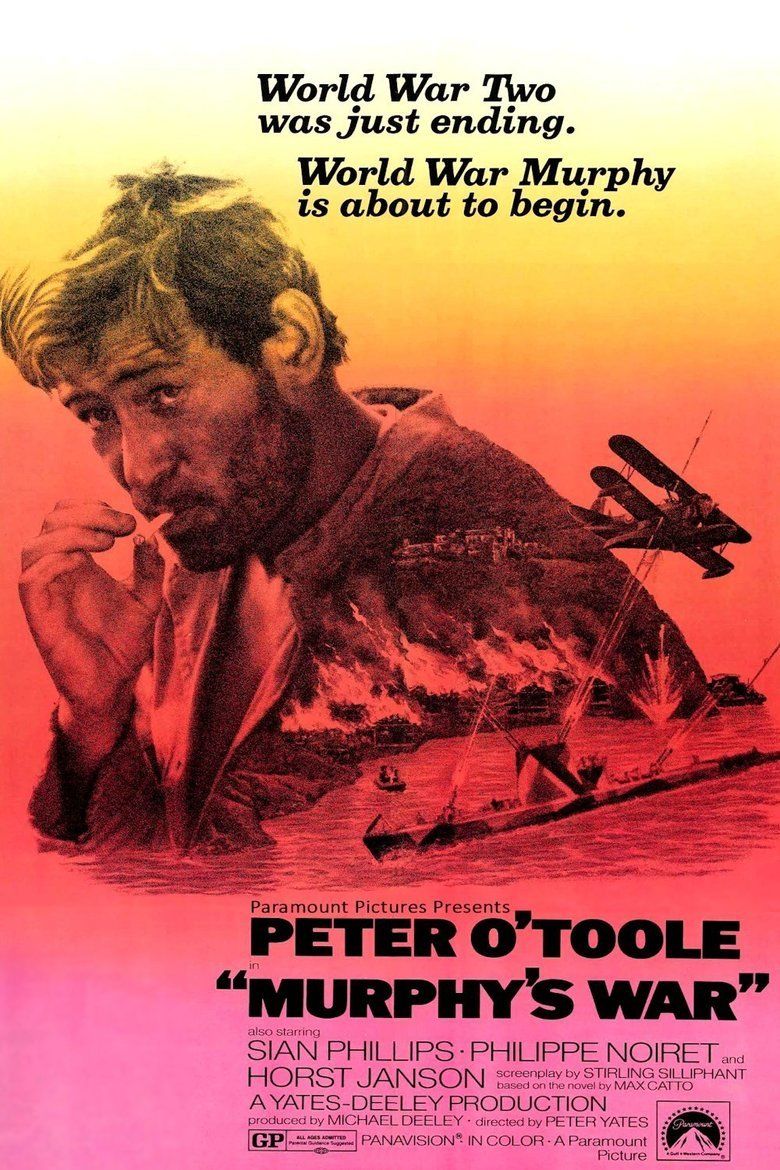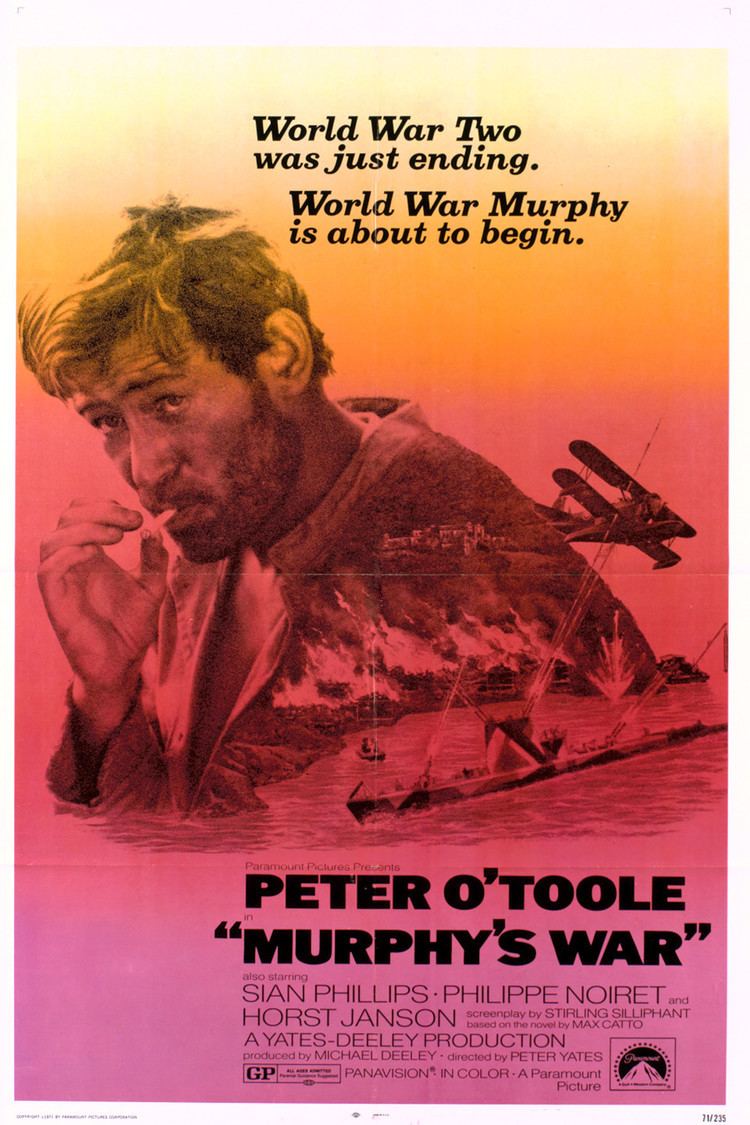Murphys War
7.2 /10 1 Votes7.2
Initial DVD release June 10, 2003 Duration Country UK/U.S. | 7/10 IMDb Genre Drama, War Language English and German | |||||||||||||||||||||||||||||||||
 | ||||||||||||||||||||||||||||||||||
Release date 1971 (1971) Initial release January 13, 1971 (United Kingdom) Cast Peter O'Toole (Murphy), (Brezan), (Hayden), (Cmdr. Lauchs), (Lt. Ellis), John Hallam (Ellis)Similar movies Mad Max: Fury Road , Taken 3 , John Wick , Furious 7 , The Exterminator , The Hunger Games: Catching Fire | ||||||||||||||||||||||||||||||||||
Murphy's War is an Eastmancolor 1971 Panavision war film starring Peter O'Toole and Siân Phillips. It was directed by Peter Yates, based on a novel by Max Catto. The cinematography was by Douglas Slocombe.
Contents

Murphy's War is set in South America, in the backwaters of the global conflict (World War 2). it focuses on a stubborn survivor of a sunken merchant ship who is consumed in his quest for revenge and retribution against the German submarine which had sunk his ship.

Plot
In the closing days of World War II, Irishman Murphy (Peter O'Toole) is the sole survivor of the crew of a merchant ship, Mount Kyle, which had been sunk by a German U-boat and the survivors machine-gunned in the water. Murphy makes it ashore (to a missionary settlement on the Orinoco in Venezuela) where he is treated by a pacifist Quaker doctor, Dr Hayden (Siân Phillips).
When he discovers the U-boat is hiding farther up river, under the cover of the jungle, he sets about obsessively plotting to sink it by any means, including using a surviving Grumman J2F Duck floatplane from the Mount Kyle. The floatplane had been recovered, the wounded pilot later being shot dead in his hospital bed by the U-boat captain, in order to preserve the secret of the sub's location and, presumably, its action in shooting survivors in the water.
Murphy learns how to fly the aircraft in the most daring way, getting it out on the choppy waters of the river and discovering how the controls work by trial and error. Murphy soon finds the U-boat's hiding place and attempts to bomb it using home-made Molotov cocktail bombs, which fails. Meanwhile, word has come that Germany has surrendered, but Murphy is obsessed with revenge and makes plans to ram the U-boat with a floating crane owned by the friendly Frenchman Louis (Philippe Noiret). This also fails as the U-boat dives under him. However, the submerged U-boat becomes stuck in a mud bank. Murphy uses the crane to recover an unexploded torpedo fired earlier from the U-boat and drops it on the trapped crew, killing them. Murphy is also killed, as the explosion from the torpedo causes the crane jib to pin him to the deck as the floating crane sinks to the river bed.
Cast
Production
Paramount Pictures agreed to provide half the finance of the film in exchange for world distribution rights. The other half of the budget came from London Screenplays, a finance company. Michael Deeley says that he and Peter Yates turned down the chance to make The Godfather (1972) to make this film.
Director Yates said he was particularly interested in "the way in which three people — Murphy, a doctor and a Frenchman left in the backwash of war — are really brought together by circumstance and how each character plays on the other and makes them do things that they wish they hadn't and things they sometimes feel proud of."
Siân Phillips, who played the love interest, was appearing opposite her then-husband O'Toole. The married couple had previously appeared together in the 1964 film Becket and the 1969 musical film Goodbye, Mr. Chips.
Filming began on 23 February 1970, and was completed with location filming in Malta on 5 July, having filmed at a number of locations in the regions of Puerto Ordaz and Castillos de Guayana on the Orinoco River in Venezuela, as well as set filming at Pinewood Studios, Iver Heath and Twickenham Film Studios, Middlesex, England . Deeley described the shoot as the toughest of his career and it led to the breakup of his partnership with Peter Yates, with whom he had made several films.
The scenes filmed in Malta depict the burning of the merchant ship, after it has been torpedoed by the U-boat. For these particular scenes O'Toole was called upon to swim through water afire with oil and with explosives going off right and left of him. "I used to do all my own stunts when I first started" he said. "I made it a principle. Everything in Lawrence of Arabia I did myself. But after suffering a paralyzed hand, a bad back, broken ankle and countless knocks, I decided never again. It was stupid. Films employ stunt men. They can do these things far better than I. I refused to do any more stunts. [Then] I thought, well, just one more time. So I talked myself into it. In Venezuela I even fly a seaplane. If you want to see a picture of sheer terror have a look at the shots of me when I first fly that seaplane."
Several of the sequences were extraordinarily photographed by Douglas Slocombe, including the scenes of Murphy piloting the floatplane and the visuals along the Orinoco River. Especially notable is a spectacular airborne shot of a flock of scarlet ibises in flight along the shore of the river during the closing credits. The extensive flying scene involves many shots of the floatplane veering sharply to avoid buildings, the jungle and stalling – for that sequence, a camera was strapped to the wing of the aircraft.
Several Peace Corps volunteers serving in towns near the Orinoco River were recruited to play Nazi submariners. The volunteers donated their daily wages to the Venezuelan school districts or other organizations with whom they were working at the time.
The Type IX U-boat was portrayed by the Venezuelan Navy's ARV Carite (S-11); this was the former USS Tilefish, which had been sold to Venezuela in 1960. The floating crane was a former World War II tank landing craft. The OA-12 Duck used in the film was restored and flown by Frank Tallman and is on display at the National Museum of the United States Air Force at Wright-Patterson Air Force Base in Dayton, Ohio. In the original book, the aircraft was a Fairey Swordfish.
Reception
Murphy's War was not well received either critically or at the box office. Roger Greenspan's review in The New York Times centred on the awkwardness of the plot. "The sense of a film in which nothing quite works with anything else pervades "Murphy's War," and it extends from such crucial technical details as the sloppy and finally tedious cross-cutting between things (the seaplane, the motor barge, etc.) and the people who are supposed to be operating them, to the playing together of the principal actors." Although's O'Toole's performance was praised, another review in The New York Daily News called the film a "... sluggish action spectacle."
References
Murphy's War WikipediaMurphys War IMDb Murphys War themoviedb.org
